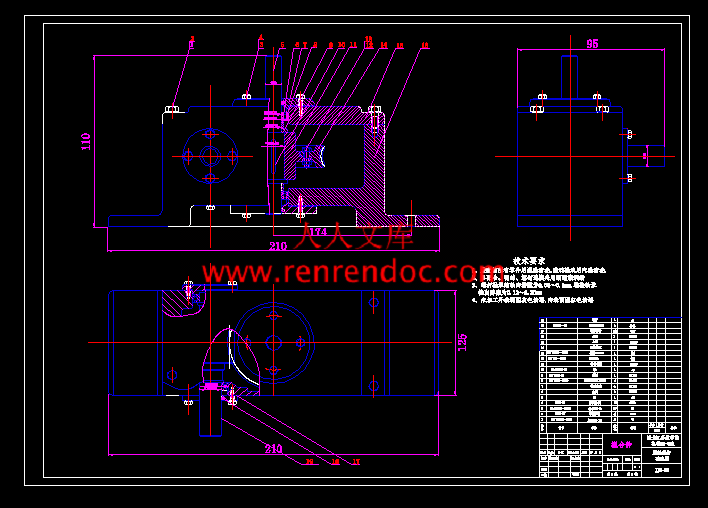五自由度机器人结构设计
66页 24000字数+说明书+外文翻译+开题报告+3张CAD图纸+电路图
Backup of Sheet1.Sch
Previous Backup of Sheet1.Sch
五自由度教学演示机器人结构总装图.dwg
五自由度机器人结构设计开题报告.doc
五自由度机器人结构设计说明书.doc
实习日记.doc
控制原理图.DDB
程序框图.dwg
蜗轮蜗杆减速器.dwg
目 录
摘要1
Abstract2
第1章绪论1
1.1机器人概述1
1.1.1机器人的诞生与发展1
1.1.2国内发展状况2
1.1.3国外机器人发展趋势3
1.2机器人产业对教育、培训的要求及本课题的提出3
第2章总体设计方案5
2.1总体设计的思路5
2.2总体方案的确定5
2.2.1坐标形式的选择6
2.2.2驱动系统的类型选择6
2.2.3各部位传动机构的确定6
2.2.4外形尺寸和运动范围的确定7
2.2.5控制系统的确定7
第3章结构设计及计算9
3.1手部夹持器的结构设计9
3.1.1概述9
3.1.2手部的结构和手指形状的确定9
3.1.3手部驱动力的计算和电机的选择10
3.2腕部结构设计13
3.2.1概述13
3.2.2腕部结构设计14
3.3臂部及机身(底座)的设计计算18
3.3.1概述18
3.3.2结构设计计算19
第4章控制系统设计25
4.1控制系统方案的确定25
4.1.1控制方案的确定25
4.1.2驱动方式的确定25
4.1.3控制系统类型的确定25
4.1.4步进电机控制方式的确定26
4.1.5直流电机控制方式的确定26
4.1.6键盘及显示方式的确定26
4.2演示系统的组成26
4.3驱动电路的研制29
4.3.1恒流源型步进电机驱动电路的研制29
4.3.2双极型PWM直流力矩电机的驱动电路的研制31
4.3.3光电码盘的选择和辩向电路的研制,33
4.3.4直流电机的闭环控制系统的研制。36
4.3.5以单片机为核心的机器人控制系统的研制36
第5章技术经济分析46
第6章教学机器人演示系统演示实验的设计47
6.1实验一 教学机器人演示系统的组成及结构47
6.2实验二:教学机器人控制系统的演示实验48
结论50
专题部分:——旋转电机的分类及其总结51
致谢61
参考文献62
摘要
随着机器人技术的飞速发展,工业机器人的应用领域正在不断的扩大,对教育培训部门提出了新的要求,为提高机器人教学的水平,我们研制了一套以实验教学为目的的机器人演示系统。
本文阐述了机器人的发展历程,国内外的应用现状,及其巨大的优越性,提出具体的机器人设计要求,进行了本演示系统的总体方案设计和各自由度具体结构设计、计算;对演示系统的控制部分的研制,其中包括:进电机开环控制;光电码盘为反馈元件的,以PWM型功放电路为驱动器的直流电机闭环控制;以89C51单片机为核心,实现演示系统的键盘管理和LCD显示,并以单CPU分时控制形式,实现机器人运动的点位控制方式。
最后设计制定出利用本演示系统所开设的几个实验的指导书。
关键字:教学机器人、结构设计、闭环控制、演示实验
国外机器人领域发展近几年有如下几个趋势:1.工业机器人性能不断提高(高速度、高精度、高可靠性、便于操作和维修),而单机价格不断下降,平均单机价格从91年的10.3万美元降至97年的6.5万美元。 2.机械结构向模块化、可重构化发展。例如关节模块中的伺服电机、减速机、检测系统三位一体化;由关节模块、连杆模块用重组方式构造机器人整机;国外已有模块化装配机器人产品问市。 3.工业机器人控制系统向基于PC机的开放型控制器方向发展,便于标准化、网络化;器件集成度提高,控制柜日见小巧,且采用模块化结构;大大提高了系统的可靠性、易操作性和可维修性。 4.机器人中的传感器作用日益重要,除采用传统的位置、速度、加速度等传感器外,装配、焊接机器人还应用了视觉、力觉等传感器,而遥控机器人则采用视觉、声觉、力觉、触觉等多传感器的融合技术来进行环境建模及决策控制;多传感器融合配置技术在产品化系统中已有成熟应用。 5.虚拟现实技术在机器人中的作用已从仿真、预演发展到用于过程控制,如使遥控机器人操作者产生置身于远端作业环境中的感觉来操纵机器人。 6.当代遥控机器人系统的发展特点不是追求全自治系统,而是致力于操作者与机器人的人机交互控制,即遥控加局部自主系统构成完整的监控遥控操作系统,使智能机器人走出实验室进入实用化阶段。美国发射到火星上的“索杰纳”机器人就是这种系统成功应用的最著名实例。 7.机器人化机械开始兴起。从94年美国开发出“虚拟轴机床”以来,这种新型装置已成为国际研究的热点之一,纷纷探索开拓其实际应用的领域。
机器人产业对教育、培训的要求及本课题的提出
采用机器人会给我们带来很大的方便,机器人和其他自动化装置最主要的区别在于机器人的功能和任务很容易修改或改变,仅需要改变软件就可以了,同时机器人比一般自动化装备更复杂,需要更多的软件和硬件知识,故一旦大量采用机器人就需要专门的培训使用机器人的具有较高水平和技术人员,这无疑对教育和培训提出新的要求,大多数机器人专家都反复的强调需要制定培训计划以为新的工作岗位准备合格的劳动力。
谈到培训,还有个协调的问题,工业和教育团体应减少培训与需求的协调失误,在校学生也应了解市场情况,在教师的协助下开设和调整自己的课程,使所学的专业和技能在毕业的时候满足社会的需求。
对机器人,人们的头一个问题就是:机器人是否会造成失业?应该说大量采用机器人会使一部分人丧失工作,然而这一新的产业所创造的新的就业机会比其消灭的职业更多,新的职业需要新的技能,就再需要教育和培训,再次证明,机器人对社会的冲击就是再培训的课题。
大量采用机器人不回带来失业,在机器人的研究、制造和应用上有七种职业,即研究、开发、设计、制造、应用、市场、服务、维修和教育,而潜在的部门是机器人制造部门,教育机构和机器人相关部门。现在国外机器人制造厂家不仅自己开设机器人课程也向学校提供资助 ,为学校提供机器人教学系统,据资料显示,美国有很多大学开设了机器人课程。
早我国,许多大学也开设了机器人方面的课程(如上海交大,华中科技大学等),也有很多研究开发机器人的研究机构,但资金问题是困饶机器人发展的障碍,在教学中也面临相同的问题。但教学课程上,只是纸上谈兵,没有一点直观的印象,关键是设备问题,研制一个价格低廉、性能优越、结构简单、能给学生以深刻印象的实验用的教学演示系统,在这前提和背景下,提出本课题,它能达到以下目标:
成本低,必要时可以降低精度要求,因为是实验演示装置。
机械结构简单,便于学生掌握机器人结构上的特点。
整体尺寸不宜过大,以摆放实验台为准。
与结构相匹配,为降低成本,采用开环、闭环控制相结合
各部分结构最好方便拆卸,以便维修保养。


 川公网安备: 51019002004831号
川公网安备: 51019002004831号